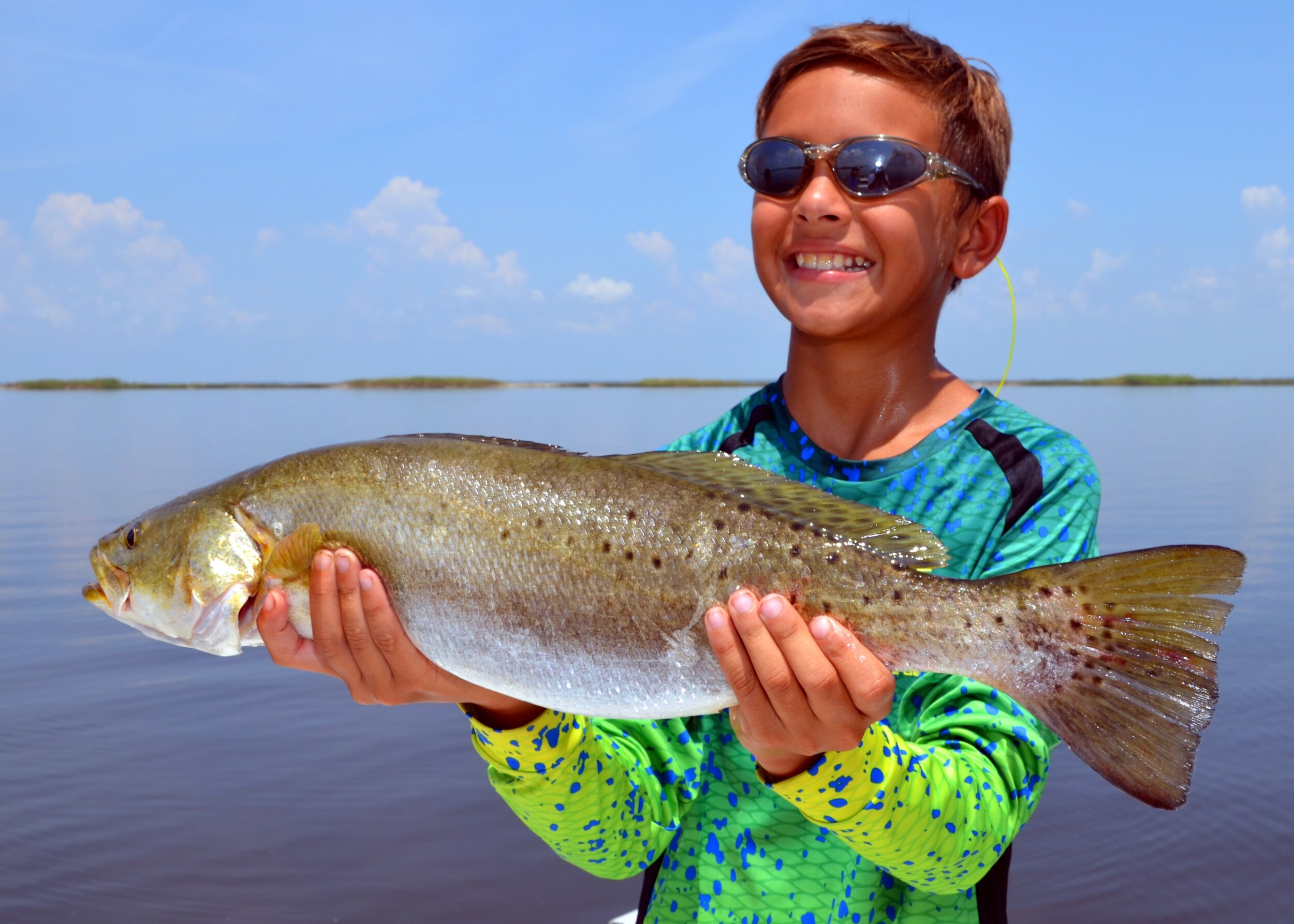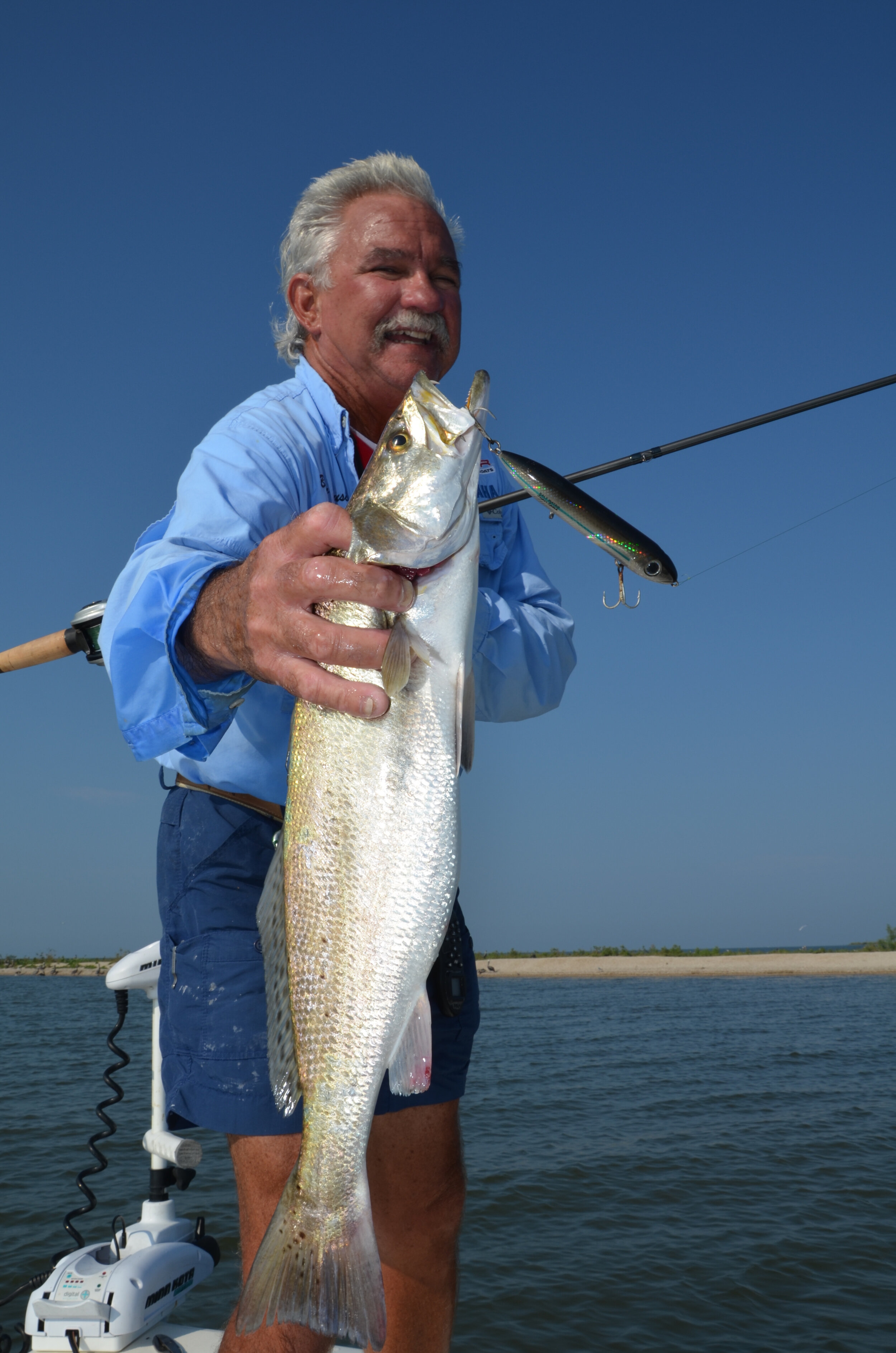Fishing Friday: Trophy Trout - Fishing for Monsters Takes Time, Patience, and Luck
By: John N. Felsher
Everyone hears stories about novice anglers who land lunkers on their first fishing adventures. Sure, anyone can catch a massive fish on any cast, but to consistently catch trophy speckled trout takes work, patience and perseverance waiting long hours for that one big bite.
“Sometimes, fishing for big trout is about as exciting as watching ice melt – until one hits!” quipped Kirk Stansel of Hackberry Rod and Gun (888-762-3391, www.hackberryrodandgun.com) who guides on the famed trophy trout waters of Calcasieu Lake south of Lake Charles, La. “It can be pretty slow when looking for that one big strike.”
To catch snaggle-toothed monsters, anglers must find them. That means getting away from crowds and ignoring anglers filling ice chests with smaller trout. Loners, huge speckled trout, or spotted seatrout, act more like redfish or largemouth bass. They hunt alone or with other trout of similar size. Instead of running down prey in open water, large specks typically lurk around cover such as oyster reefs, rock piles, sunken boats, jetties, platforms, bridge pilings and other places where they can ambush prey.
Jacob Wood shows off a speckled trout he caught while fishing in the Calcasieu Estuary near Lake Charles, La. One of the premiere trophy trout lakes, Calcasieu Lake can produce some double-digit specks.(Photo by John N. Felsher)
Trophy trout also need access to deep water. Isolated reefs near channel drops make great places to fish for whoppers. Big trout don’t feed every day and generally stay in deeper water when not actively feeding. When they want to hunt, they rise and prowl the shallows looking for bait and ambush places.
“Big trout wait for something to come to them,” explained Chad Peterek, (361-920-3474, www.captchadpeterek.com) from Corpus Christi, Texas. “When I’m looking for big trout, I like to fish close to a drop-off. I’ve caught more big trout within 500 yards of a big drop than anywhere else. When it’s cooler, I fish over a drop-off and throw deep. During warmer weather, I like to fish shallow, but close to an area with a sharp drop-off.”
In clear flats like in parts of Texas and Florida, trout hunt sea grass patches. Grass doesn’t grow uniformly. Look for whitish open patches, or sand holes, punctuating the dark vegetation. Lunker specks frequently hide at the edges looking into the sand holes waiting to attack anything that swims too close.
Over grass beds, fish soft-plastic fluke-type lures in baitfish colors such as pearl or dark backs with white bellies. Rig them weightless with hook points inserted into the plastic. Lures rigged like this can slip through the most entangling cover. If necessary, add a small split-shot to the line, but use only enough weight to make long casts possible. Throw the bait into the grass and let it sink. When it hits the top of the grass, twitch it. Don’t move it too fast. Just take up the slack and let it sink naturally. When it hits bottom in a sand hole, hop it a few times.
Ronnie Daniels of Fisher-Man Guide Services shows off a speckled trout he caught on a topwater bait while fishing in Mississippi Sound near Pass Christian, Miss. Topwater baits like this walk-the-dog style lure mimic mullets and other baitfish and make an excellent choice for tempting larger speckled trout. (Photo by John N. Felsher)
Beaches may look sterile, but they create great places to find lurking lunkers. Wave action configures the bottom like old washboards, building humps and carving troughs. Shore-bound anglers commonly catch huge fish if they find the right spot on the beach.
While no speck would pass on an opportunity to slurp a hapless shrimp or other succulent morsel that swims temptingly close, large trout normally want one big meal. Until a speck reaches about two pounds 80 percent of its diet consists of shrimp. As trout grow, they eat more fish. Massive trout usually want to grab one big meal that doesn’t require too much energy to catch rather than chase down several tiny creatures. Find the right bait to find big trout.
Giant trout love mullets, which regularly feed on the surface and even stick their heads out of the water. Baits that imitate mullets produce big results. People can catch trophy trout on just about any artificial bait, but large topwater baits frequently produce the most strikes from the biggest specks.
“For big trout, I like throwing topwater baits,” commented Ronnie Daniels of Fisher-Man Guide Services (228-323-1115, msfisherman.com) in Pass Christian, Miss. “Topwater baits have larger profiles, so they tend to draw strikes from bigger fish. Throwing topwater baits is not only a very effective way to fish for big trout, but in my opinion the most enjoyable way!”
Bobby Abruscato of A-Team Fishing Adventures shows off a speckled trout he caught on a topwater walking bait while fishing in the Mississippi Sound near Bayou La Batre, Ala. Walking baits make a zigzag motion across the surface. With larger profiles, topwater baits usually attract larger speckled trout. (Photo by John N. Felsher)
Most saltwater fishermen prefer “walk-the-dog” lures. These heavy baits sail long distances, making great search baits. The biggest fish usually strike the farthest away from the boat. These baits zigzag irresistibly from side to side like crippled mullets struggling near the surface.
“My favorite topwater bait is a full-sized pink Rapala Skitter Walk,” recommended Bobby Abruscato of A-Team Fishing Adventures (251-661-7696, www.ateamfishing.com) in Mobile, Ala. “I usually hop it five or six times and then ‘kill it’ for a few moments. Then, I start working it again. Every now and then, I like to change the tempo a bit. Sometimes, fish want something specific. They might hit a bait right when it starts moving or while it’s moving. What a trout wants can change from one spot to the next.”
When all else fails, offer trout squirming meat. In a good spot, place several rods holding various temptations – and wait! Live mullets, menhaden, pinfish and croakers about five to eight inches long all make excellent trophy trout baits.
Many anglers free-line live baitfish. In deeper water, fish a Carolina rig. Slip a sliding weight on the line and tie a barrel swivel to the end to keep the weight from sliding down to the hook. On the swivel, attach 24 to 48 inches of fluorocarbon leader and a circle hook. Since line pulls easily through the slip sinker, baitfish can swim around freely and wily old trout don’t feel the weight when they gulp a bait.
Topwaters baits, like this walk-the-dog style bait, can prove highly effective for enticing speckled trout, especially bigger ones. (Photo by John N. Felsher)
The world record speck weighed 17 pounds, 7 ounces and came from near Fort Pierce, Fla. Also in Florida, try Tampa Bay and the Indian River/Mosquito Lagoon between Titusville and Sebastian. Other good trophy trout waters include Baffin Bay/Lower Laguna Madre, Texas, Sabine Lake on the Texas/Louisiana line, Calcasieu Lake in southwest Louisiana and Lake Pontchartrain by New Orleans.
Originally from Louisiana, John N. Felsher is a professional freelance writer who lives in Semmes, Ala. An avid sportsman, he’s written more than 2,900 articles for more than 157 different magazines on a wide variety of outdoors topics. Follow him on the internet. He also hosts an outdoors tips show for WAVH FM Talk 106.5 radio station in Mobile, Ala. Contact him at j.felsher@hotmail.com or through Facebook.
Have you done something interesting outdoors? Join Global Outdoors and write a review to tell everyone about it! We’re building the home for trusted reviews of outdoor experiences, outfitters, and guides. Help us out and you’ll be entered to win free trips!






